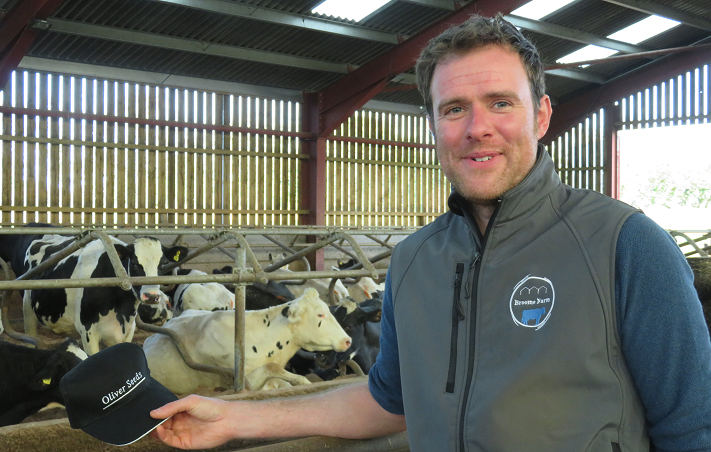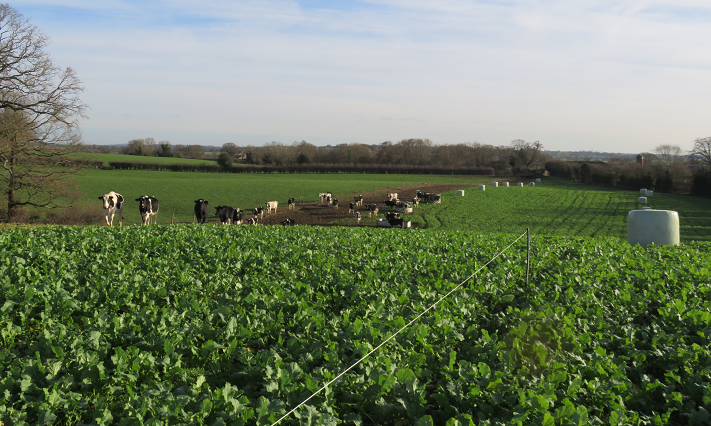Published
25 .Mar.2019Forage options save the day
Dairy farmer takes drastic action to ensure there was enough forage to feed over winter
Dairy farmer Stephen Willis was set to expand his herd to 600 cows, but last year’s awkward growing season saw cattle numbers pegged back to make sure there was enough forage to feed this winter.
Stephen farms 142ha at Broome Farm near Ellesmere, with an additional 142ha of rented land three miles away for growing forage and rearing 350 head of youngstock. Extra cow housing has just been completed and a new rotary parlour will be installed later this year.
“We had planned to be milking 600 cows by mid summer this year,” says Stephen. “But we wouldn’t have had enough forage to feed them all. We sold 75 of the worst performers and kept 425 through winter.”
The 650kg Friesian cross Holstein cows produce on average 8,250 litres of milk a year, sold to the Co-Op supermarket. The target is to gain between 3,000 to 4,000 litres from forage.
“We are looking to produce as much milk as economically as possible,” Stephen explains. “We are not striving for maximum yields – but enough to cover our costs, service our debts and have some money to live on.”
The cows calve all year around and are kept in three groups – of high, mid and low yielders. The lows are out grazing from early March on the easier, free draining land and the rest follow as ground conditions allow.

Mix of forages
Stephen aims to grow 2,000 tonnes fresh weight of grass silage, with 2,500 tonnes fresh weight of maize silage and an additional 850 tonnes fresh weight of lucerne, which was drilled under a spring barley crop in 2017. He usually expects a large first cut of grass, around 1500 tonnes fresh weight – but in 2018 harvested just 750.
“The wet and cold winter, followed by a lot of heat in April meant the quantity and quality of grass for first cut was going backwards,” says Stephen.
Last year, winter wheat was drilled in November to be made this summer into wholecrop or alkalage, depending on how much maize silage is left. If it has all been eaten, alkalage will be made to boost the starch element of the ration, until the next maize crop is harvested.
In the third week of October after the maize harvest, Stephen drilled Tornado catch crop ryegrass to boost this year’s silage stocks.
He also planted a forage rape/kale hybrid on 11.4ha of light land to overwinter 80 heifers. Bales of lucerne silage are offered with each strip. This field will be reseeded with a grazing mixture in the spring.

“I start with a plan with how much forage I need to last the year ahead, including any summer buffer feeding,” explains Stephen.
“I will take early first and second cuts – but then am flexible whether I need to take a third, fourth or even a fifth. If the maize is growing well, I put more silage fields into grazing.”
“There is a question mark over the lucerne,” he admits. “It is very expensive to bale and it can be tricky to get it harvested just right. I might move to doing more wholecrop in future.”
Contractors are used for all the machinery work, including ploughing, drilling, fertilising, muck spreading and silage harvesting and storage.
Urea is applied in February across the grassland, followed by ammonium nitrate later in the year. Slurry is applied via an umbilical system across the farm and farmyard manure is spread on maize ground.
More from grazing
In the past few years, Stephen has improved his grazing, recognising that this is the cheapest feed.
Grazing tales place at the heart of the property, with Oliver Seeds perennial ryegrass grazing mixtures Century and Megabite being sown over the past few years and performing well.
During the grazing season grass growth is measured once a week and the data entered into the AgriNet computer system. Rotation length varies between 16 and 25 days.
High and mid yielders go onto fields growing 2,600kg DM/ha and the low yielders 2,400-2,500kg DM/ha. The highs graze down to 1,800kg DM/ha and the mids and lows down to 1,500kg DM/ha. Dry cows and heifers may follow to get covers down to 1,400kg DM/ha.
Flexibility
When the hot weather came last summer, Stephen was keen to preserve the grazing fields, particularly those on the lighter soils. A hundred high yielders were housed day and night from mid July. The mid yielders went back out to graze from the end of August until November and the low yielders stayed out grazing in the day until December. Forage stocks were low by the end of August, before the new maize crop was ready.
The lucerne did not grow for a second cut and the rain came too late to save the maize – which managed 12.5t DM/ha rather than the usual 15t DM/ha. Stephen was buying straw in November to help feed the housed youngstock.
“The grass recovered well in the kind autumn,” he says. “We are hoping the current mild winter continues, that we get a good and early cut from the westerwolds and that we have an early turnout.
“We have made a committed decision to look after our grazing and range of forage crops to the very best of our ability. I really appreciate the help from my consultants Tom Benson, Peter Long and Donald Boyd from Oliver Seeds, to help me achieve this. They are always challenging me to do better!”
This article first appeared in British Dairying, February 2019
